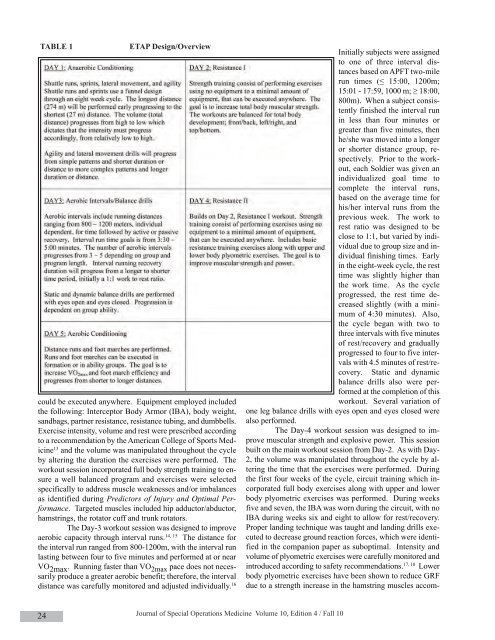Fall - United States Special Operations Command
Fall - United States Special Operations Command
Fall - United States Special Operations Command
You also want an ePaper? Increase the reach of your titles
YUMPU automatically turns print PDFs into web optimized ePapers that Google loves.
TABLE 1 ETAP Design/Overview<br />
could be executed anywhere. Equipment employed included<br />
the following: Interceptor Body Armor (IBA), body weight,<br />
sandbags, partner resistance, resistance tubing, and dumbbells.<br />
Exercise intensity, volume and rest were prescribed according<br />
to a recommendation by the American College of Sports Medicine<br />
13 and the volume was manipulated throughout the cycle<br />
by altering the duration the exercises were performed. The<br />
workout session incorporated full body strength training to ensure<br />
a well balanced program and exercises were selected<br />
specifically to address muscle weaknesses and/or imbalances<br />
as identified during Predictors of Injury and Optimal Performance.<br />
Targeted muscles included hip adductor/abductor,<br />
hamstrings, the rotator cuff and trunk rotators.<br />
The Day-3 workout session was designed to improve<br />
aerobic capacity through interval runs. 14, 15 The distance for<br />
the interval run ranged from 800-1200m, with the interval run<br />
lasting between four to five minutes and performed at or near<br />
VO 2max . Running faster than VO 2max pace does not necessarily<br />
produce a greater aerobic benefit; therefore, the interval<br />
distance was carefully monitored and adjusted individually. 16<br />
24<br />
Initially subjects were assigned<br />
to one of three interval distances<br />
based on APFT two-mile<br />
run times (≤ 15:00, 1200m;<br />
15:01 - 17:59, 1000 m; ≥ 18:00,<br />
800m). When a subject consistently<br />
finished the interval run<br />
in less than four minutes or<br />
greater than five minutes, then<br />
he/she was moved into a longer<br />
or shorter distance group, respectively.<br />
Prior to the workout,<br />
each Soldier was given an<br />
individualized goal time to<br />
complete the interval runs,<br />
based on the average time for<br />
his/her interval runs from the<br />
previous week. The work to<br />
rest ratio was designed to be<br />
close to 1:1, but varied by individual<br />
due to group size and individual<br />
finishing times. Early<br />
in the eight-week cycle, the rest<br />
time was slightly higher than<br />
the work time. As the cycle<br />
progressed, the rest time decreased<br />
slightly (with a minimum<br />
of 4:30 minutes). Also,<br />
the cycle began with two to<br />
three intervals with five minutes<br />
of rest/recovery and gradually<br />
progressed to four to five intervals<br />
with 4.5 minutes of rest/recovery.<br />
Static and dynamic<br />
balance drills also were performed<br />
at the completion of this<br />
workout. Several variation of<br />
one leg balance drills with eyes open and eyes closed were<br />
also performed.<br />
The Day-4 workout session was designed to improve<br />
muscular strength and explosive power. This session<br />
built on the main workout session from Day-2. As with Day-<br />
2, the volume was manipulated throughout the cycle by altering<br />
the time that the exercises were performed. During<br />
the first four weeks of the cycle, circuit training which incorporated<br />
full body exercises along with upper and lower<br />
body plyometric exercises was performed. During weeks<br />
five and seven, the IBA was worn during the circuit, with no<br />
IBA during weeks six and eight to allow for rest/recovery.<br />
Proper landing technique was taught and landing drills executed<br />
to decrease ground reaction forces, which were identified<br />
in the companion paper as suboptimal. Intensity and<br />
volume of plyometric exercises were carefully monitored and<br />
introduced according to safety recommendations. 17, 18 Lower<br />
body plyometric exercises have been shown to reduce GRF<br />
due to a strength increase in the hamstring muscles accom-<br />
Journal of <strong>Special</strong> <strong>Operations</strong> Medicine Volume 10, Edition 4 / <strong>Fall</strong> 10

















